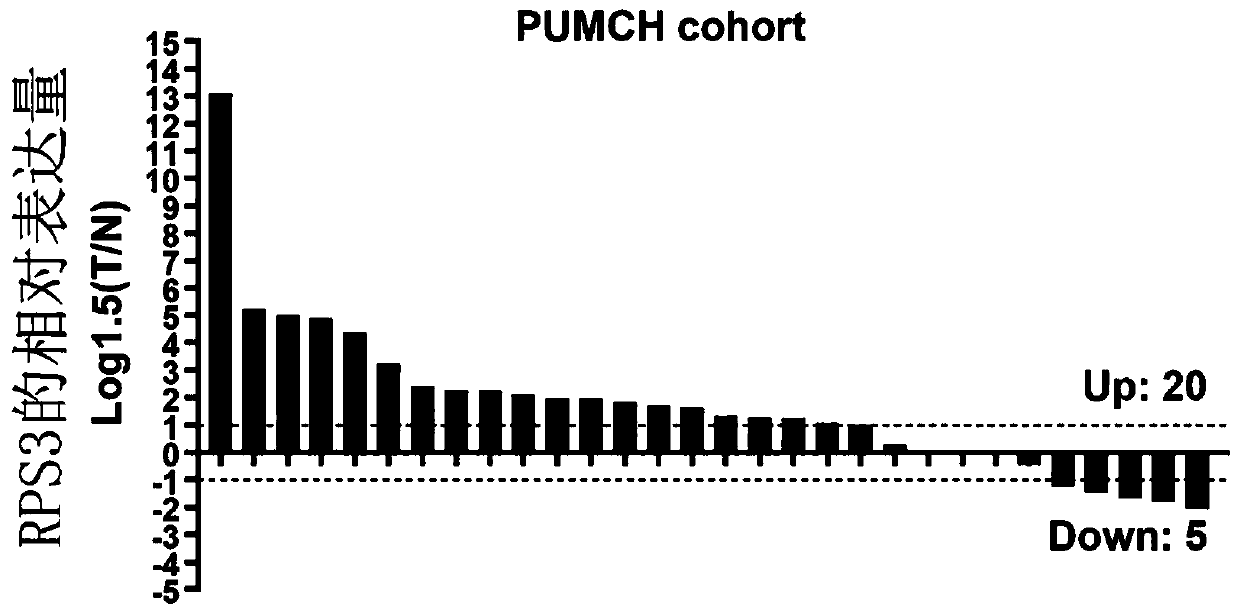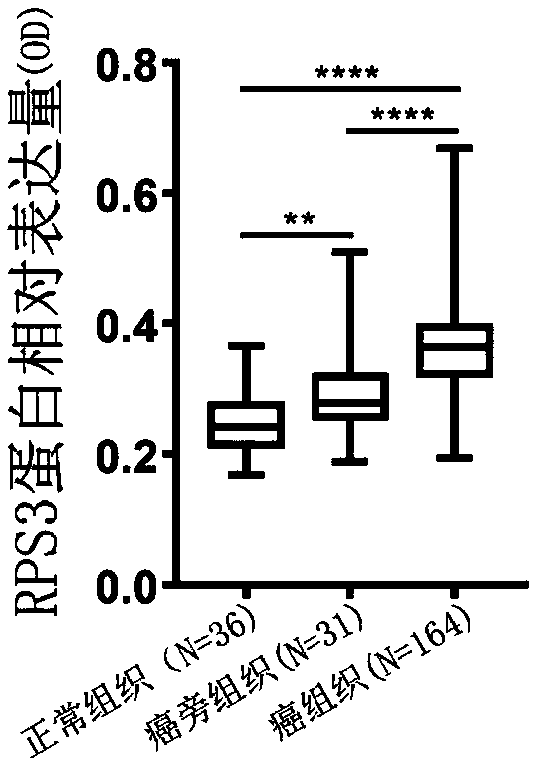Biomarker in diagnosis of liver cancer and kit containing biomarker in diagnosis of liver cancer
A biomarker and diagnostic kit technology, applied in the field of RPS3 detection, can solve the problem of unclear molecular mechanism of liver cancer and other problems
- Summary
- Abstract
- Description
- Claims
- Application Information
AI Technical Summary
Problems solved by technology
Method used
Image
Examples
Embodiment 1
[0189] Example 1 Effect of RPS3 overexpression or knockdown on the function of liver cancer cells
[0190] HepG2 and SMMC-7721 liver cancer cell lines were used to knock down RPS3 at the cell line level to verify the role of RPS3 in the proliferation, migration, invasion, EMT and clone formation ability of liver cancer cells.
[0191] Result description:
[0192] We transferred the adenovirus sh-RNA of RPS3 into HepG2 cells, and the knockdown effect was verified by Q-PCR and Western blot, which proved that the knockdown of RPS3 expression was achieved in the corresponding cells.
[0193] Normal HepG2 cells were used as the control group, and RPS3-knockdown HepG2 cells were used as the test group. After the two groups of cells were cultured, cell proliferation, clone formation, cell cycle, wound healing, and small hole mobility were detected.
[0194] For the results of cell proliferation ability and colony formation, see Figure 4 and Figure 5 . From Figure 4 It can be ...
Embodiment 2
[0200] Effect of Knocking Down RPS3 on Tumor Growth in Example 2 Nude Mouse Model
[0201] Six BALB / c mice (female, 6-8 weeks old) were used in each experiment, and RPS3-knockdown SMMC-7721 cells and normal SMMC-7721 cells were injected subcutaneously to observe the effect of RPS3 on tumorigenesis at the animal level. The impact of sex, and immunohistochemical analysis of tumor tissue to detect the expression of RPS3.
[0202] Collect RPS3 knockdown virus stable strain cells, with 3 × 10 6 The amount of cells / mouse / day was injected subcutaneously for 2 weeks, and the size of the tumor was observed and measured with a caliper. After 4 weeks, the mice were sacrificed, and the tumors were removed for immunohistochemical analysis.
[0203] After the tumor tissues of nude mice were dewaxed and dehydrated at 62°C for 2 hours, antigen retrieval was performed at 97°C for 20 minutes in citrate buffer, 3% H 2 o 2 Block endogenous peroxidase at room temperature for 10 minutes, incuba...
Embodiment 3
[0206] Example 3 Effect of FMHM on the expression of RPS3 and the function of liver cancer cells
[0207] The SMMC-7721 cells and HepG2 cells were divided into 1×10 4 The cells / well were plated, and after the cells adhered to the wall, gradient drug treatment was performed. A stock solution of FMHM was prepared in DMSO, followed by stepwise dilution with simple medium. The drug concentration gradient of FMHM was 1000 μM, 250 μM, 62.5 μM, 15.625 μM, 3.906 μM, 0.977 μM, 0.244 μM, 0.061 μM, 0.0152 μM, 0.0038 μM, 0.000954 μM. After 48 hours, the cell growth curve was drawn. Calculate the IC50 (half maximal inhibitory concentration, half inhibitory concentration) of FMHM according to the concentration and cell survival rate, and obtain the optimal concentration of FMHM for different cell lines: SMMC-7721 cells are 32.42 μM, HepG2 cells are 15.8 μM, and this concentration is used as Subsequent experimental doses.
[0208] Different liver cancer cells were treated with different ...
PUM
| Property | Measurement | Unit |
|---|---|---|
| diameter | aaaaa | aaaaa |
Abstract
Description
Claims
Application Information
 Login to View More
Login to View More - R&D
- Intellectual Property
- Life Sciences
- Materials
- Tech Scout
- Unparalleled Data Quality
- Higher Quality Content
- 60% Fewer Hallucinations
Browse by: Latest US Patents, China's latest patents, Technical Efficacy Thesaurus, Application Domain, Technology Topic, Popular Technical Reports.
© 2025 PatSnap. All rights reserved.Legal|Privacy policy|Modern Slavery Act Transparency Statement|Sitemap|About US| Contact US: help@patsnap.com



